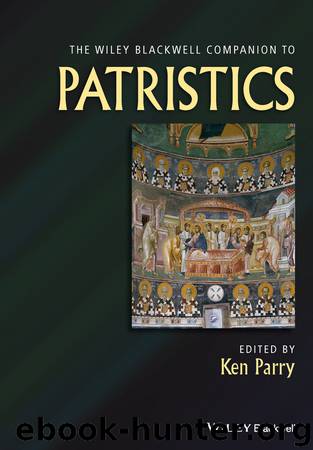Patristics by Parry Ken;

Author:Parry, Ken; [Parry, Ken]
Language: eng
Format: epub
Publisher: John Wiley & Sons, Incorporated
Published: 2015-08-06T00:00:00+00:00
Reception in Seventeenth to Twentieth Centuries
Maximos seems not to have been much known in the period of the Renaissance and the Reformation/Counter Reformation that ensued. The first edition of his works did not appear until 1675 in an incomplete edition by Francis Combefis (a third volume that would have completed the edition was ready by the time he died in 1679, but never published); the missing texts, most importantly the Ambigua, were only published by F. Oehler in 1867.
In the Greek East, now under the Ottoman yoke, Maximos continued to be read in monastic circles, something confirmed by his being the writer most fully represented in the Athonite anthology of ascetic texts, the Philokalia, compiled by St Makarios of Corinth and St Nikodimos the Athonite (Venice, 1782). Included are the four Centuries on Love, the two Centuries on Theology and the Oikonomia, and the five Centuries on Diverse Texts, presented as a continuation of the Two Centuries, with, finally, the Exposition of the Lord’s Prayer. The selection leans strongly towards the ascetic side of the Confessor’s teaching, though there are many demanding chapters in the Centuries on theology. The Philokalia was destined to have a profound influence on Orthodox theology and spirituality, which contributed to a wider reception of the theology of St Maximos (though this influence is mitigated by the fact that the Slavonic translation omitted Maximos’ treatises altogether, while the Russian translation included only a selection (Conticello and Conticello 2002: 1006–1007). In the nineteenth century, Maximos benefited from the extensive program of translation of patristic texts, fostered by Metropolitan Philaret of Moscow; by the end of the century, Russian theologians had easy access to a vast range of patristic texts in Russian translation, including those of the Confessor.
Modern scholarship on Maximos the Confessor began in the Slav world with S.L. Epifanovič’s Prepobodnyi Maksim Ispovedik i vizantiskoe bogoslove (“St Maximos the Confessor and Byzantine theology”: Kiev, 1915) and Materialy k izučeniju žizni I tvorenij prep. Maksima Ispovednika (“Materials for the study of the life and works of St Maximos the Confessor”: Kiev, 1917). This latter published 37 texts hitherto unknown, or known only partially (not all of which have turned out to be genuine). Maximos was, however, by no means unknown to Russian theologians: Vladimir Solov’ev had read him; Pavel Florensky (1997: 312) cites him several times in his monumental Pillar and Ground of the Truth, at one point making him a key witness to his controversial ideas on friendship; Sergei Bulgakov finds in Maximos’ doctrine of the logoi the essentials of his sophiology (Bulgakov 2008: 126 n.) and draws on him for his middle way between Filioquism and Monopatrism in the doctrine of the procession of the Holy Spirit (Bulgakov 2004: 91–92); in the lectures that he gave at the newly established Institut St-Serge in Paris, Georges Florovsky (1987: 208–253) gives a well-rounded account of the theology of the Confessor. However, by this time, the loadstar of Orthodox theology was increasing becoming St Gregory Palamas.
Epifanovič’s work was soon
Download
This site does not store any files on its server. We only index and link to content provided by other sites. Please contact the content providers to delete copyright contents if any and email us, we'll remove relevant links or contents immediately.
The Gnostic Gospels by Pagels Elaine(2420)
Jesus by Paul Johnson(2252)
Devil, The by Almond Philip C(2230)
The Nativity by Geza Vermes(2134)
The Psychedelic Gospels: The Secret History of Hallucinogens in Christianity by Jerry B. Brown(2083)
Forensics by Val McDermid(1989)
Going Clear: Scientology, Hollywood, and the Prison of Belief by Lawrence Wright(1894)
Going Clear by Lawrence Wright(1882)
Barking to the Choir by Gregory Boyle(1738)
Old Testament History by John H. Sailhamer(1719)
Augustine: Conversions to Confessions by Robin Lane Fox(1701)
The Early Centuries - Byzantium 01 by John Julius Norwich(1663)
A History of the Franks by Gregory of Tours(1645)
Dark Mysteries of the Vatican by H. Paul Jeffers(1619)
The Bible Doesn't Say That by Dr. Joel M. Hoffman(1614)
A Prophet with Honor by William C. Martin(1611)
by Christianity & Islam(1568)
The First Crusade by Thomas Asbridge(1546)
The Amish by Steven M. Nolt(1496)
